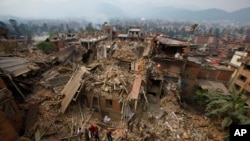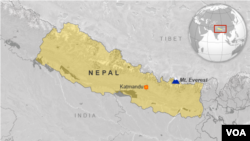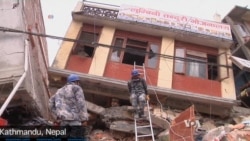Residents of Nepal's capital sought refuge outside overnight night, fearful of further aftershocks after a massive earthquake rocked much of the country Saturday, killing more than 3,200 people and injuring several thousand others.
Communications systems from rural areas have been knocked out by the earthquake. The death and injury tolls are expected to rise when word comes in from those areas.
Saturday's 7.8 magnitude quake struck 80 kilometers northwest of Kathmandu, destroying large parts of the capital's historic center. Sunday's 6.7 aftershock was among at least 18 smaller quakes that shook the Kathmandu area since.
Citing Nepali government sources, the United Nations said 35 of the country's 75 districts are affected. Some 30 million people live in Nepal.
VOA correspondent Steve Herman reports that emergency officials in Kathmandu say they are "overwhelmed" with rescue and assistance requests from across the country.
Disaster response teams from the United States and other nations are deploying to help search, rescue and recovery efforts.
On a website established by the International Committee of the Red Cross, hundreds of Nepalis and foreigners are reported missing by their loved ones. Far fewer have checked in on the site to report they are alive.
The earthquake rocked the mountainous region minutes before noon local time on Saturday, flattening historic structures of wood and brick in the ancient capital city. At least 180 people were reported dead when the city's iconic Dharahara Tower - a UNESCO world heritage site - collapsed.
To the east, avalanches shook Mt. Everest - the highest point on earth - killing at least 18 climbers, injuring many others and burying entire base camps.
By early Sunday, sources reported to VOA deaths and extensive property damage in the Tibet Autonomous Region, hundreds of kilometers north of Kathmandu.
At least 34 people were killed in India, as other partial casualty reports from far-flung regions came from Bangladesh, Bhutan and elsewhere in the vast and remote Nepal-Chinese border regions.
US aid
The United States expressed condolences for the lives lost and pledged an immediate $1 million for disaster relief.
Secretary of State John Kerry said in a statement, "We are working closely with the government of Nepal to provide assistance and support. ... USAID is preparing to deploy a Disaster Assistance Response Team and is activating an Urban Search and Rescue Team to accompany disaster experts and assist with assessments of the situation."
Additionally, the Obama administration activated an elite Virginia-based earthquake rescue team, and told another renowned team of specialists in Los Angeles to prepare for deployment.
The 56-member unit deployed Sunday along with several USAID officials en route to Nepal.
India’s foreign secretary, Subrahmanyam Jaishankar, said three tons of supplies and 40 members of India's National Disaster Response Force were flying to Nepal. The country is also evacuating its nationals by air.
China, Germany and Israel are among the countries also sending disaster personnel to the area.
Kapil Shrestha, a professor at Tribhuvan University, was among the more fortunate residents of the Nepalese capital, Kathmandu. Although his house developed multiple cracks after the powerful earthquake, he said he was able to spend Saturday night indoors.
But tens of thousands of others were not so fortunate and continued to camp on streets and in parks for a second day.
Shrestha said it was a sleepless night for the Himalayan country as repeated tremors and aftershocks hit the region and the sounds of helicopters on rescue missions ripped the air.
“Overnight the whole city looked like a refugee camp, living in makeshift tents, makeshift places, all displaced people. Now I can understand what kind of pain and what kind of problems these refugees would go through," he said.
"The aftershocks keep coming ... so people don't know what to expect," Sanjay Karki, Nepal country head for global aid agency Mercy Corps, told The Associated Press. "All the open spaces in Kathmandu are packed with people who are camping outdoors. When the aftershocks come you cannot imagine the fear. You can hear women and children crying."
In India, where thousands of Nepalese work, 50-year-old Om Prashad struggled to communicate with his family in the remote village of Argakhachi. The low-income worker was devastated after hearing that the house he built just last year with his savings was severely damaged.
Worried about corruption in his country, he doubts whether he will get any assistance.
Medical help
On Sunday, rescuers continued to struggle to pull more bodies out of the rubble of homes and buildings.
Doctors raced to attend to the thousands of injured who flooded hospitals. Many had to be treated in makeshift areas set up in tents or parking lots. As supplies ran out, hospitals scrambled to get medicines.
Rescue operations are under way throughout the mountainous kingdom. Nepal's neighbors, including India and Pakistan, sent condolences and were scrambling to provide assistance.
Saturday's earthquake was the strongest in 81 years in Nepal, since an even mightier jolt in 1934 that killed more than 10,000 people.
The massive scale of the tragedy unfolded in the hours after the earthquake flattened homes, damaged buildings, and split open walls and roads in the bustling Kathmandu Valley - home to 2.5 million people and Nepal’s main cities. Historic structures made of wood and unmortared brick were leveled.
Aid workers warned that the situation could be far worse near the epicenter. The U.S. Geological Survey said the quake was centered near Lamjung, about 80 kilometers (50 miles) northwest of Kathmandu, in the Gorkha district.
Roads to that area were blocked by landslides, hindering rescue teams, chief district official Prakash Subedi told AP. Teams were trekking through mountain trails to reach remote villages, and helicopters would also be deployed, he said by telephone.
The aid group World Vision said in a statement that remote mountain communities, including in Gorkha, were totally unprepared for the level of destruction caused by the earthquake.
The earthquake also triggered an avalanche at the Mount Everest Base Camp, killing several guides and mountaineers and flattening many tents. Romanian climber Alex Gavan tweeted, “Running for life from my tent.” Thousands of foreign nationals were reported to be in Nepal for the spring trekking season.
Some information for this report came from AP.
WATCH: The devastation caused by a massive earthquake Saturday in Nepal.












